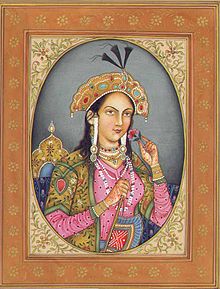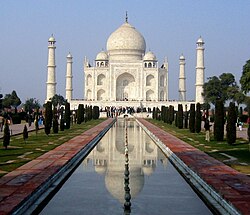Mumtaz Mahal


Mumtāz Mahal (Persian, Urdu: ممتاز محل; pronunciation /mumtɑːz mɛhɛl/; meaning "beloved ornament of the palace") is the common nickname of Arjumand Banu Begum, who was born in April, 1593 in Agra, India. Her father was the Persian noble Abdul Hasan Asaf Khan, the brother of Nur Jehan who subsequently became the wife of the emperor Jahangir, and she was religiously a Muslim. She was married at the age of 19, on May 10, 1612, to Prince Khurram, who would later ascend the Peacock Throne as Mughal emperor Shah Jahan I. She was his third wife, and became his favorite. She died on June 17, 1631 in Burhanpur in the Deccan (now in Madhya Pradesh) during the birth of their fourteenth child, a daughter named Gauhara Begum. Her body was buried in the Taj Mahal in Agra.
Biography
Not much is known about her except that she was a woman of legendary beauty and virtue, who had a very deep and loving marriage with Shah Jahan. Even during her lifetime, poets would extol her beauty, gracefulness and compassion. Mumtaz Mahal was Shah Jahan's trusted companion, travelling with him all over the Mughal Empire. He trusted her so far that he even gave her his imperial seal, the Muhr Uzah. Mumtaz was portrayed as the perfect wife with no aspirations to political power in contrast to Nur Jehan, the wife of Jahangir who had wielded considerable influence in the previous reign.[1] She was a great influence on him, apparently often intervening on behalf of the poor and destitute. But she also enjoyed watching elephant and combat fights performed for the court. It was quite common for women of noble birth to commission architecture in the Mughal Empire. Mumtaz devoted some time to a riverside garden in Agra and it may have been her affection for this garden that prompted the eventual form of her monument,the Taj Mahal.[1]
In 1607 CE (1016 AH), Prince Khurrum had been betrothed to Arjumand Banu Begum, whom was just 14 years old at the time. She would become the unquestioned love of his life. They would however, have to wait five years before they were married in 1612 CE (1021 AH). After their wedding celebrations, Khurram "finding her in appearance and character elect among all the women of the time", gave her the title 'Mumtaz Mahal' Begum (Chosen One of the Palace).[2] 18 AH). The intervening years had seen Khurrum take two other wives. By all accounts however, Khurram was so taken with Mumtaz, that he showed little interest in exercising his polygamous rights with the two earlier wives, other than dutifully siring a child with each. According to the official court chronicler, Qazwini, the relationship with his other wives "had nothing more than the status of marriage. The intimacy, deep affection, attention and favour which His Majesty had for the Cradle of Excellence (Mumtaz) exceeded by a thousand times what he felt for any other."[3][4][2]
Despite her frequent pregnancies, Mumtaz travelled with Shah Jahan's entourage throughout his earlier military campaigns and the subsequent rebellion against his father. She was his constant companion and trusted confidant and their relationship was intense. Indeed, the court historians go to unheard of lengths to document the intimate and erotic relationship the couple enjoyed. In their nineteen years of marriage, they had thirteen children together[1], seven of whom died at birth or at a very young age.
Mumtaz died in Burhanpur in 1631 CE (1040 AH), after the childbirth of their thirteenth child.[5] She had been accompanying her husband whilst he was fighting a campaign in the Deccan Plateau.[6] Her body was temporarily buried at Burhanpur in a garden known as Zainabad on the bank of the Tapti River.[5] Legend has it that on her deathbed, her last wish to the emperor was for a symbol or a monument to their love. She also asked her husband not to marry anyone. Inconsolable, the emperor promised immediately. [citation needed] The contemporary court chroniclers paid an unusual amount of attention to Mumtaz Mahal's death and Shah Jahan's grief at her demise. In the immediate aftermath of his bereavement, the emperor was reportedly inconsolable..[7] Apparently after her death, Shah Jahan went into secluded mourning for a year.[citation needed] When he appeared again, his hair had turned white, his back was bent, and his face worn. Jahan's eldest daughter, the devoted Jahanara Begum, gradually brought him out of grief and took the place of Mumtaz at court. Immediately after the burial in Burhanpur, Shah Jahan and the imperial court devoted itself to the planning and design of the mausoleum and funery garden in Agra.[7] It took more than 20 years to finish her tomb, the Taj Mahal.
Today, the Taj Mahal stands as the ultimate monument to love, and an homage to her beauty and life.
Children
1. Shahzadi Huralnissa Begum (March 30, 1613 - June 14, 1616)
2. Shahzadi (Imperial Princess) Jahanara Begum ) (April 2, 1614 - September 16, 1681)
3. Shahzada (Imperial Prince) Dara Shikoh (March 30, 1615 - September 8, 1659)
4. Shahzada Mohammed Sultan Shah Shuja Bahadur (July 3, 1616 - 1660)
5. Shahzadi Roshanara Begum (September 3, 1617 - 1671)
6. Badshah (Emperor) Mohinnudin Mohammed Aurangzeb| (November 3, 1618 - February 21, 1707)
7. Shahzada Sultan Ummid Baksh (December 18, 1619 - March, 1622)
8. Shahzadi Surayya Banu Begum (June 10, 1621 - April 28, 1628)
9. Shahzada Sultan Murad Baksh (September 8, 1624 - December 14, 1661)
10. Shahzada Sultan Luftallah (November 4, 1626 - May 14, 1628)
11. Shahzada Sultan Daulat Afza (May 9, 1628 - ?)
12. Shahzadi Husnara Begum (April 23, 1630 - ?)
13. Shahzadi Gauhara Begum (June 17, 1631 - 1706)
